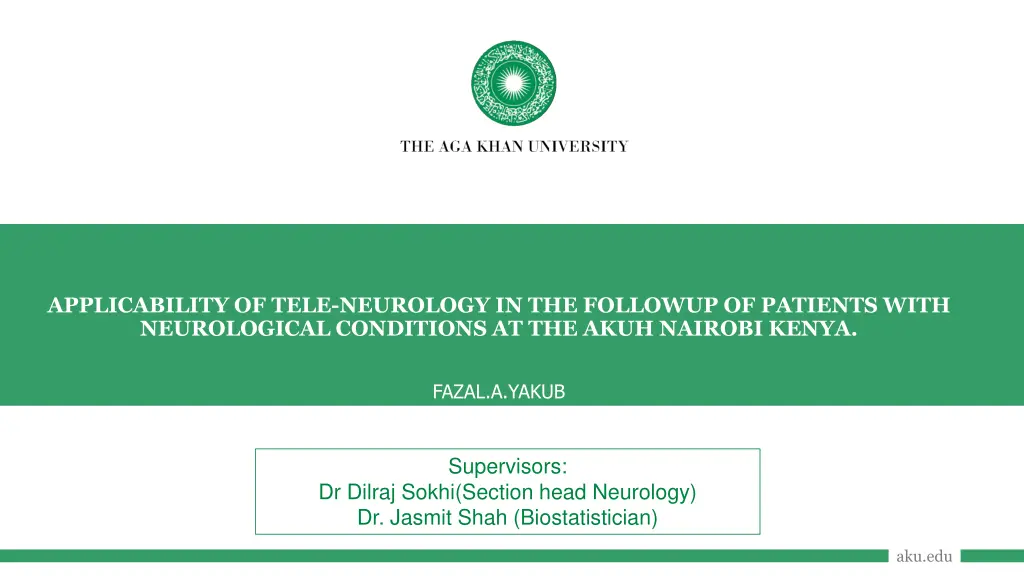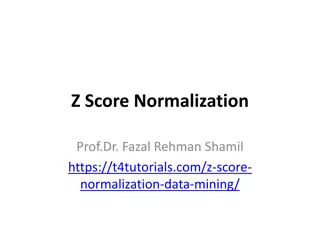
Tele-Neurology for Improved Patient Follow-up at AKUH Nairobi Kenya
Explore the potential of tele-neurology for enhancing patient care and follow-up in Nairobi, Kenya. Understand the impact of neurological conditions globally and the effectiveness of tele-neurology in various regions. Research the feasibility of outpatient tele-neurology services at the Aga Khan University Hospital, driven by the need for expanded neurology services and the challenges posed by the COVID-19 pandemic.
Download Presentation

Please find below an Image/Link to download the presentation.
The content on the website is provided AS IS for your information and personal use only. It may not be sold, licensed, or shared on other websites without obtaining consent from the author. If you encounter any issues during the download, it is possible that the publisher has removed the file from their server.
You are allowed to download the files provided on this website for personal or commercial use, subject to the condition that they are used lawfully. All files are the property of their respective owners.
The content on the website is provided AS IS for your information and personal use only. It may not be sold, licensed, or shared on other websites without obtaining consent from the author.
E N D
Presentation Transcript
APPLICABILITY OF TELE-NEUROLOGY IN THE FOLLOWUP OF PATIENTS WITH NEUROLOGICAL CONDITIONS AT THE AKUH NAIROBI KENYA. FAZAL.A.YAKUB Supervisors: Dr Dilraj Sokhi(Section head Neurology) Dr. Jasmit Shah (Biostatistician) aku.edu
Background A systemic analysis conducted between the years 1991-2016 identified neurological conditions as the leading cause of disease adjusted life years (DALYs) and second cause of mortality after cardiovascular associated death(1) 12 out of 100 deaths globally are due to a neurological condition(2). Sub Saharan Africa (SSA) contributes to two third of the global neurological disease burden. aku.edu
What is Tele-Neurology? Delivery of health care services by means of electronic communication. It serves as a means of bringing specialist services to an underserviced location. The WHO defines it as the use of ICT to exchange valid and critical medical information between a health care provider and a patient with distance being the critical factor (3) Synchronous Vs Asynchronous methods. aku.edu
Tele-neurology around the globe. 1999-advent of tele-stroke emerged popularized by Levine and Gorman(5) Data from the NIHSS showed that examinations done via tele-neurology and physically were comparable with similar outcomes after intravenous Tissue Plasminogen activator (tPA) was administered (4). Galveston clinic and Beaumont tele-medicine clinic found no statistical differences between epileptic patients in terms of emergency visits due to breakthrough seizures or compliance to medications (5) Rural areas such as New Mexico followed up of veterans over a period of two years with results showing a 90% satisfaction rate and 92% of the patients stating the service had saved them time and money (6). Tele neurology was effective in the follow-up of patients with primary headaches with optimum headache control as well as identification of a secondary headache that would need further evaluation (7) Similarly in China, the level of satisfaction in participants partaking in tele-health services demonstrated good outcomes when assessed using the tele-medicine satisfaction questionnaire (8) aku.edu
Research question. Is an outpatient tele neurology service feasible within the tertiary level Aga-Khan University Hospital? aku.edu
Justification: Extend neurology services to patients and facilitate easier follow up of patients. The Covid 19 pandemic. aku.edu
Objectives Primary objective To determine patient satisfaction in engaging with the proposed tele-neurology service. To determine patient satisfaction in engaging prior one on one neurology consults. Secondary objectives To determine the cost benefit of patients attending tele-neurology clinic. To determine the travel time and the waiting time to see a neurologist in the tele- neurology clinic vs traditional ambulatory clinic. To determine carbon footprint burden in tele neurology patient s vs traditional ambulatory aku.edu
Methodology Study design: A descriptive prospective cross-sectional study. Location of study Aga Khan University Hospital Nairobi (AKUHN) Study population Patients seen at the neurology clinic at Aga-Khan University Hospital aku.edu
Patient recruitment: NEUROLOGY PATIENTS NEW PATIENTS FOLLOW-UP Walk in patient Nurse led triage by phone Neurologist led triage by phone Triggers for F2F Patient agrees Patient disagrees Tele-consultation Neurologist led triage by phone Triggers tele- consult Follow-up patient Follow-up Triggers for F2F aku.edu
Sample size ? = Level of confidence ? = Proportion of satisfaction ?2? (1 ?) ?2 ? = ? = Precision rate N =Sample Size Proportions formula A study by Davis et al (2014) (24) showed that 90% of the patients were fully satisfied with their tele-neurology visit. Based on the above formula and 95% level of confidence, with 90% satisfaction rate, and 5% precision rate, the minimum sample size required for our study would be 122 patients. After adjusting an attrition rate of 15%, the minimum required sample size for this study would be 140 patients. aku.edu
RESULTS: Demographic Characteristics (N = 146) n % Age (Years) (mean [SD]) 44.0 [16.5] Age (Years) (median [IQR]) 40.9 [30.6, 55.2] Male 54 37.0% Gender Female 92 63.0% 219 patients enrolled: Duration (months) Ataxia 1 0.7% Bells palsy 1 0.7% 146 responded to a TNC. 108 had previously had F2F. Burning scalp syndrome 1 0.7% carpal tunnel 1 0.7% Cluster headaches 1 0.7% CRION 1 0.7% Dementia 12 8.2% Dystonia 1 0.7% Epilepsy 38 26.0% -Female: 63.0% Fibromyalgia/Functional disorder 1 0.7% Fibromyalgia/MDD 1 0.7% Functional disorder 1 0.7% -Median Age: 40.9 years (IQR 30.6,55.2) Headache 1 0.7% Disease Herpetic neuralgia 1 0.7% HIE 1 0.7% IIH 4 2.7% Migraine 38 26.0% MND 1 0.7% MS 3 2.1% -Most common dx: Epilepsy, Migraines 26%. Myasthenia Gravis 5 3.4% Neuropathy 9 6.2% Occipital Neuralgia 1 0.7% Parkinsons 9 6.2% Spondylosis 2 1.4% Stroke 6 4.1% Syrinx 1 0.7% -4/146 from neighboring countries. Tremor 2 1.4% Trigeminal neuralgia 2 1.4% Vertigo 1 0.7% aku.edu
For Tele-neurology consultation: Post Tele Service Survey (n = 146) Disagree Neutral Agree I am satisfied with the care received in tele-medicine (n=145) 8 (5.5%) 12 (8.3%) 125 (86.2%) The mean level of satisfaction was 4 (SD 1). Saved time [3.0 (2.0-4.0) hours] Travel [11.0 (7.2-21.1) km] Cost [$10 (5-20)]; The quality of sound were adequate to talk to my specialist doctor My family is satisfied with the care received in tele-medicine 8 (5.5%) 28 (19.2%) 110 (75.3%) Tele-medicine helps me know my state of health 11 (7.5%) 27 (18.5%) 108 (74.0%) I felt comfortable talking to my specialist doctor through a microphone 7 (4.8%) 7 (4.8%) 132 (90.4%) Talking to my specialist was as effective as in person 22 (15.1%) 28 (19.2%) 96 (65.8%) My specialist doctor has identified my health problem through tele-medicine 22 (15.1%) 40 (27.4%) 84 (57.5%) 4 (2.7%) 8 (5.5%) 134 (91.8%) The time with a specialist is faster with tele medicine 6 (4.1%) 14 (9.6%) 126 (86.3%) I prefer telemedicine because it is easier than to go to the hospital (n=145) 18 (12.4%) 22 (15.2%) 105 (72.4%) Telemedicine saves me time travelling to hospital or a specialist clinic 8 (5.5%) 5 (3.4%) 133 (91.1%) In total, our TNC service saved our patients $6,125, 1,143 hours, and 25,506km of travel, equating to 3.5 tons (21 trees) of carbon dioxide emissions. I find telemedicine an acceptable way to receive health-care services My specialist doctor was able to answer my questions through telemedicine (n=145) 4 (2.8%) 8 (5.5%) 133 (91.7%) 13 (8.9%) 23 (15.8%) 110 (75.3%) I will use telemedicine services again 6 (4.1%) 22 (15.1%) 118 (80.8%) I trust that my personal information and privacy will be protected after my attention by tele medicine (n=143) 3 (2.1%) 10 (7.0%) 130 (90.9%) *Disagree is aggregated with Totally Disagree; *Agree is aggregated with Totally Agree aku.edu
CONCLUSION: Spectrum of disorders locally and at a global context mirror each other (7,8,9.) Our study demonstrates that our regionally unique TNC service is an acceptable, efficient, effective, and environmentally- friendly care delivery model in our resource-poor setting. aku.edu
ASANTE! aku.edu
REFERENCES. 1. Feigin VL, Nichols E, Alam T, Bannick MS, Beghi E, Blake N, et al. Global, regional, and national burden of neurological disorders, 1990 2016: a systematic analysis for the Global Burden of Disease Study 2016. The Lancet Neurology. 2019;18(5):459-80. 2.Sarfo FS, Adamu S, Awuah D, Ovbiagele B. Tele-neurology in sub-Saharan Africa: A systematic review of the literature. Journal of the neurological sciences. 2017;380:196-9. 3. Aarli JA, Diop AG, Lochm ller H. Neurology in sub-Saharan Africa: a challenge for World Federation of Neurology. Neurology. 2007;69(17):1715-8. 4.Wechsler LR. Advantages and limitations of teleneurology. JAMA neurology. 2015;72(3):349-54. 5. Rasmusson KA, Hartshorn JC. A comparison of epilepsy patients in a traditional ambulatory clinic and a telemedicine clinic. Epilepsia. 2005;46(5):767-70. 6. Davis LE, Coleman J, Harnar J, King MK. Teleneurology: successful delivery of chronic neurologic care to 354 patients living remotely in a rural state. Telemedicine and e-Health. 2014;20(5):473-7 7. Morgan DG, Kosteniuk J, Stewart N, O'connell ME, Karunanayake C, Beever R. The telehealth satisfaction scale: reliability, validity, and satisfaction with telehealth in a rural memory clinic population. Telemedicine and e-Health. 2014;20(11):997-1003. 8. 20(11):997-1003.Yip M, Chang AM, Chan J, MacKenzie AE. Development of the Telemedicine Satisfaction Questionnaire to evaluate patient satisfaction with telemedicine: a preliminary study. Journal of Telemedicine and Telecare. 2003;9(1):46-50. aku.edu

